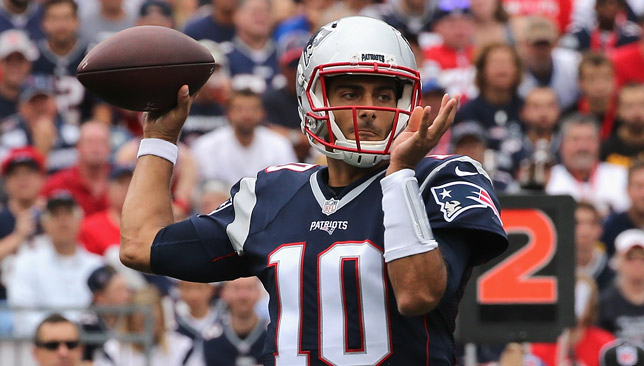
Contrary to what many NFL executives and coaches might continue to believe, there isn’t a steadfast rule of thumb on how to handle young quarterbacks, even now in the modern day.
If there was any notion remaining that there’s a right way and a wrong way to develop one, it has been smashed like an episode of ‘MythBusters’.
It’s the age-old question. Should you throw a young quarterback into the flames and allow him to learn on the fly, or sit them out and bring them on slowly?
Between three young signal callers – Jimmy Garoppolo, Carson Wentz and Jared Goff – we’ve witnessed three equally different approaches through the first two weeks of the season. Granted two games is a small sample size, but the results so far have backed up what history should have taught us by now: situation and context matter more than playing time.
Garoppolo had filled in so well for the suspended Tom Brady and guided New England to a perfect record before suffering a shoulder injury, that it’s easy to point to his previous two years spent behind the future Hall of Famer as evidence for why he’s succeeding now.
We’ll never know if Garoppolo could have done this if he had been forced into action as a rookie, but it’s hard to argue learning under the tutelage of Brady and the two years under his belt getting familiar with the Patriots’ offence hasn’t helped.
No2 draft pick Wentz, on the other hand, didn’t have that luxury before taking control of the team, but it hasn’t seemed to matter. The Philadelphia Eagles rookie has impressed and the coaching staff has been one reason why he’s transitioned so well from the second-tier Football Championship Subdivision (FCS) in college.
It's @CJ_Wentz's 2nd career NFL game... And he's already throwing into triple coverage with ease. 😯 #PHIvsCHI https://t.co/XuqadjJVEC
— NFL (@NFL) September 20, 2016
Check out the experience on the resume of the Eagles’ coaching staff. In particular, head coach Doug Pederson’s background is highlighted by time spent as a QBs coach and offensive coordinator.
It’s no wonder then he’s putting Wentz in positions to succeed with first-down throws to keep defences off-balance, as well as short passes to ease his decision-making.
The quarterback Wentz was drafted after, top overall selection Jared Goff, hasn’t even seen a snap, despite the Los Angeles Rams failing to find the end zone.
That makes you wonder, if Goff isn’t an upgrade over Case Keenum right now, what does that say about his prospects going forward?
But the Rams’ offence isn’t exactly quarterback-friendly. Weapons are severely lacking and the scheme doesn’t do many favours. If Goff played, he would do nothing but struggle, so there is some worth in shielding him from instant failure.
New England and Philadelphia are seeing positive results for their approaches, but for all the criticism they’re getting, LA could benefit down the road.
BRADFORD CAN SAVE VIKINGS’ SEASON
If we knew in pre-season the Minnesota Vikings would lose both Teddy Bridgewater and Adrian Peterson to serious injuries, we would have considered it a death knell.
And yet, Minnesota appear to be doing just fine thanks to their stout defence and the quick emergence of Sam Bradford.
The former was expected to be a strength coming into the year, but it’s more than lived up to expectations to be one of the best units in the league by almost any metric.
Nice work, Mr. Bradford. 👏 #SKOL pic.twitter.com/PSDjahsyqM
— NFL (@NFL) September 19, 2016
Bradford, on the other hand, was a surprise in his first game in a Vikings uniform. When they gave up a massive haul of draft picks to Philadelphia to trade for the quarterback, Minnesota were criticised for chasing an average stopgap to fill their void at the position.
Bradford probably isn’t ever going to be elite, but there’s a reason why he was the first overall draft pick in 2010 – the talent is there, he’s just either been in bad situations or injured.
A big determinant of his success with the Vikings will be how well the offensive line blocks, otherwise he may not even finish out the season, but the 28-year-old has shown in his lone appearance that he’s more than capable of moving the ball perhaps even better than Bridgewater by averaging 9.23 yards per pass attempt.
It’s early and we’ve seen Bradford tantalise us before, but it’s not a stretch to think he’s found a home.